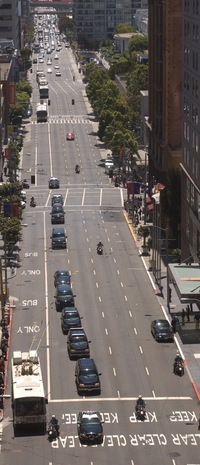Macworld 2008 round-up
 The MacBook Air was what I was waiting for (I pre-ordered the SSD version just before the online Apple Store buckled under the load). I have a MacBook Pro 15″, and because of its weight I end up leaving it at work and not carry it with me at all times (the MacBook is hardly any lighter). Sure, the Air has drastically limited connectivity (the lack of Gigabit Ethernet is probably what I will regret most, even though I clocked my Airport Extreme at 90 true Mbps throughput). Other minuses include the glossy screen (instead of an anti-reflective one), the MacBook-like chiclet keyboard rather than the much nicer MacBook Pro keyboard), or the sealed non user-replaceable battery.
The MacBook Air was what I was waiting for (I pre-ordered the SSD version just before the online Apple Store buckled under the load). I have a MacBook Pro 15″, and because of its weight I end up leaving it at work and not carry it with me at all times (the MacBook is hardly any lighter). Sure, the Air has drastically limited connectivity (the lack of Gigabit Ethernet is probably what I will regret most, even though I clocked my Airport Extreme at 90 true Mbps throughput). Other minuses include the glossy screen (instead of an anti-reflective one), the MacBook-like chiclet keyboard rather than the much nicer MacBook Pro keyboard), or the sealed non user-replaceable battery.
I suspect people deriding it are people whose main machine is a laptop. My main machine is a tower desktop, and no laptop is ever going to compete in terms of capacity and expandability. The drive on the laptop is merely a cache for the desktop where the real data lives. The compromises the Air makes are acceptable ones in exchange for a machine that is light enough for me to carry all the time. I was considering getting an Asus Eee PC prior to the show, and the MacBook Air is a vastly more capable and polyvalent machine.
Apart from that, the show was a relatively quiet one with few truly noteworthy new products. Here are the main highlights:
-
Matias did not have the Tactilepro 2.0 keyboard on display. I love mine (a version 1 with the ALPS keyswitch) and would like to get a spare, but apparently they have parted ways with the manufacturer of the new Matias-designed keyswitches and are working on a 3.0 version for later this year.
-
Fujitsu were demonstrating an ultra-small, bus-powered document scanner, the S300M. Unfortunately, once again for reasons due to licensing of the bundled software, they could not release a single SKU that would work with both PCs and Macs.
-
The German company Project Wizards was demonstrating Merlin, a project management program similar to Microsoft Project. The scheduling and load-leveling algorithms look at least as capable as Project 2000, and they told me the next version will allow team members to report on task advancement by simply contacting a built-in web server. Looks like a promising product.
-
Samsung showed the CLP-300 which they bill the world’s smallest color laser printer. Indeed it looks roughly the same size as my monochrome HP LaserJet 1320, and much smaller than my bulky HP 2605dn, that’s quite an achievement. I am wary of Samsung lasers since buying the CLP-500 for Kefta a few years back. The print quality was fine, but it was ludicrously slow, taking something like 5 minutes per color page to print. The CLP-300 seems reasonably fast, faster than the 2605dn at any rate.
-
Samsung was also showing off the gorgeous XL30 30″ LED-backlit LCD monitor. LED backlight is more environmentally friendly, does not shift colors as it ages unlike a TFT backlight, and gives a wider color gamut. Unfortunately, its price is a princely “between $6000 and $7000”.
-
Microsoft was showing off Office 2008, emphasizing ease of use and productivity rather than features for features’ sake for a change.

They even set up a bloggers-only salon to curry favor, complete with Internet cafe and snacks.
- I tried Nikon’s humongous AF-S VR Nikkor 200mm f/2G IF-ED lens. Very heavy but impressive piece of gear.
- Canon was showing off the new Flash-based HD camcorders they introduced at CES. They are not that much smaller than the HDV ones. The HV30 replaces the excellent HV20, but the only real improvements are 1080p30 mode and an articulating LCD.
 I have been living and working in downtown San Francisco for almost eight years now. Until a month ago, my office window (right) used to overlook Third Street and the Moscone center. San Francisco is a popular convention destination (one wonders why proctologists seem to prefer it to, say, Detroit) but Macworld Expo is definitely the biggest show in town. Restaurants and hotels are taken by storm, taxis become scarce, traffic gets even snarlier and the lines at Metron eateries cross the threshold of ludicrousness. So here are a few tips for Macworld attendees to have a better time and not caught in tourist traps.
I have been living and working in downtown San Francisco for almost eight years now. Until a month ago, my office window (right) used to overlook Third Street and the Moscone center. San Francisco is a popular convention destination (one wonders why proctologists seem to prefer it to, say, Detroit) but Macworld Expo is definitely the biggest show in town. Restaurants and hotels are taken by storm, taxis become scarce, traffic gets even snarlier and the lines at Metron eateries cross the threshold of ludicrousness. So here are a few tips for Macworld attendees to have a better time and not caught in tourist traps.